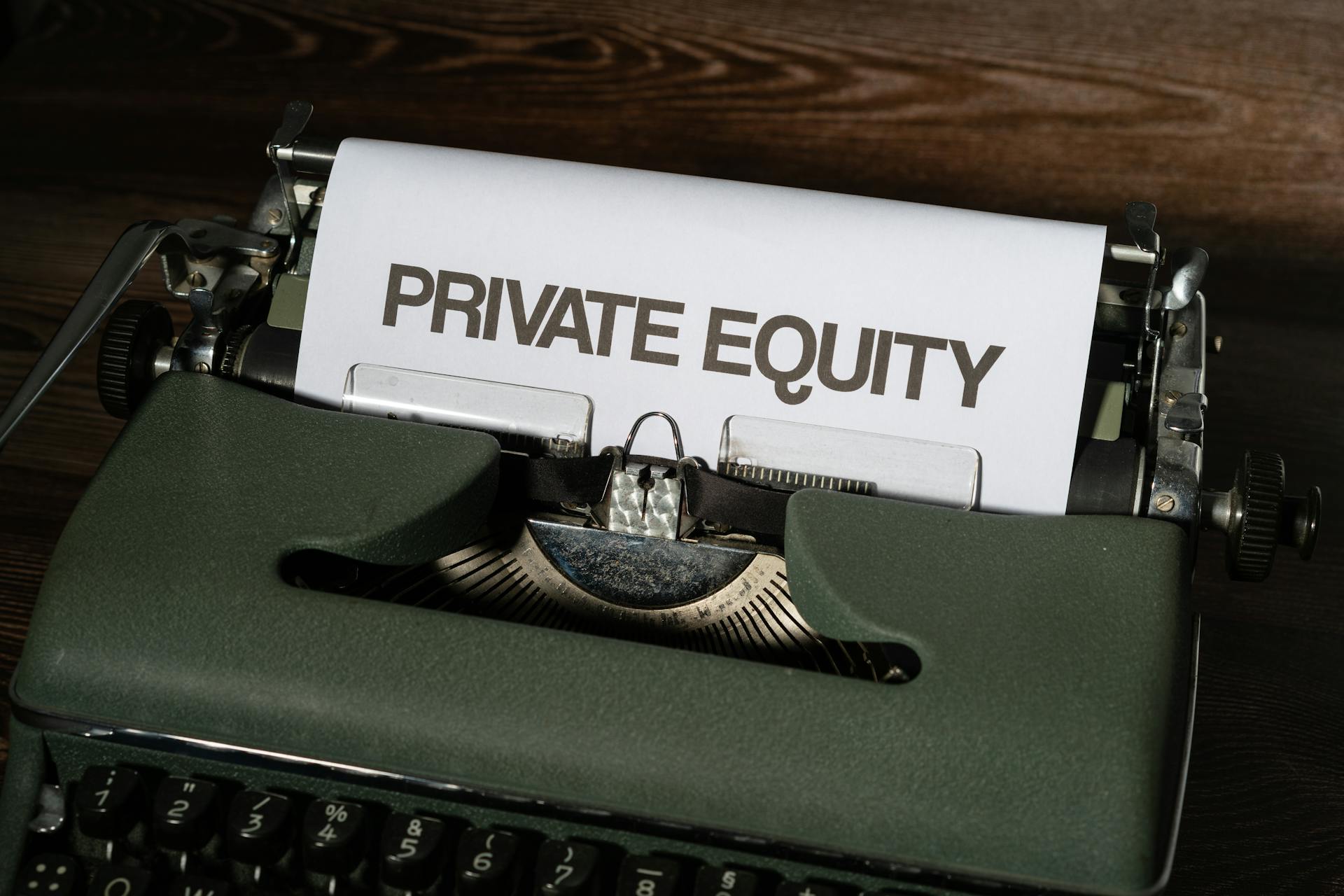
Return on Equity Finance is a powerful tool for businesses to measure their financial performance. It's a key indicator of a company's profitability.
ROE is calculated by dividing net income by shareholder equity. This metric shows how well a company uses its shareholders' investments to generate profits.
A high ROE indicates a company is using its equity effectively, while a low ROE suggests inefficiencies in the business. For example, a company with an ROE of 20% is generating $1 in profits for every $5 invested by shareholders.
Effective equity management is crucial for businesses to achieve financial success. By monitoring ROE, companies can identify areas for improvement and make informed decisions to boost their bottom line.
What Is It?
Return on equity (ROE) is a financial ratio that measures a company's profitability in relation to shareholders' equity. It shows how efficiently a company generates profits from every dollar of shareholders' equity.
ROE is calculated by dividing net income by shareholders' equity, and it's expressed as a percentage. For example, an ROE of 20% means that for every $1 of shareholders' equity, the company generates $0.20 in net income.
For another approach, see: Define Net Equity
A high ROE indicates that a company is efficiently using capital from shareholders to generate profits and growth. Investors typically prefer companies with higher ROEs as it shows the management is effectively deploying their investment.
Here are some key drivers that influence a company's ROE:
- Profit Margin: Higher profit margins mean greater net income for the company.
- Asset Turnover: Faster turnover of assets means more efficient use of capital.
- Financial Leverage: More debt financing can boost ROE but also introduces risks.
ROE varies widely across industries, so it's essential to compare it to industry averages.
Importance and Significance
Return on equity (ROE) is a crucial metric in corporate finance, allowing investors to evaluate management's profitability performance relative to the capital invested by shareholders. A high ROE indicates efficient use of capital to generate profits.
Investors generally prefer companies with sustainable double-digit ROEs, as it signals management effectiveness in deploying capital. Higher ROEs also build investor confidence.
ROE is a key metric for long-term shareholder value creation, as companies that sustain a high ROE over time tend to see their stock prices outperform the broader market. This is because a high ROE enables a company to reinvest profits and grow without needing to raise additional equity.
Here are some key factors to consider when evaluating ROE:
- ROE trends over the past 5-10 years to assess consistency.
- Comparing ROE to industry peers and the company's cost of equity capital.
- Understanding the drivers of ROE using DuPont analysis to assess quality of profits.
By considering these factors, investors can get a more complete picture of a company's profitability and shareholder value creation potential over the long run.
Calculating and Interpreting
Calculating return on equity (ROE) is a relatively straightforward process, as it divides net income by the average shareholders' equity balance in the prior and current period.
To calculate ROE, you need to know the company's net income and average shareholders' equity. This can be done using the formula: ROE = Net Income / Average Shareholders' Equity.
The ROE metric answers the question, "How much net profit is the company producing for each dollar invested by equity shareholders?" This gives you an idea of how efficiently the company handles the equity capital provided to it.
A rising ROE could come from increasing leverage to drive the Equity Multiplier higher, but this also raises risks should operating income fall. Understanding these nuances helps investors make better informed decisions.
Take a look at this: Tim Sykes Net Worth
Here's a breakdown of the two key components that drive ROE: Net Income and Shareholders' Equity.
ROE is especially used for comparing the performance of companies in the same industry. An ROE of 15–20% is generally considered good, but predicting stock value based on ROE is dependent on too many other factors to be of use by itself.
Industry Benchmarks and Comparisons
ROE varies significantly across industries, so it's essential to compare a company's ROE to its industry peers. A broad guideline suggests that an ROE above 20% is generally considered excellent.
However, some industries like software and biotech can sustain higher ROEs. For instance, a company in the software industry might have an ROE of 25% or more.
10-15% is considered a good ROE for most industries. This range indicates a company is generating decent returns on its equity. If a company's ROE falls below 10%, it may indicate issues with profitability or poor use of leverage.
To put these benchmarks into perspective, consider the following table:
Comparing a company's ROE to its industry peers and over time can provide valuable insights into its financial performance.
Strategies to Improve
Improving return on equity (ROE) requires a thoughtful approach. One of the most direct ways to boost ROE is by increasing profit margins.
Pricing optimization can significantly boost margins by finding the optimal price point without sacrificing volume. Carefully adjusting prices can increase revenues without impacting sales.
Cost-cutting is another effective strategy to expand margins without affecting revenues. Reducing operating or production costs through efficiency improvements, supply chain optimization, or automation can make a big difference.
Offering high-margin products or services can also contribute to higher ROE. Focusing on offerings with inherently higher profit margins can be a winning strategy.
A company's capital structure can impact its ROE. Adjusting the mix of debt and equity financing can enhance ROE, but finding the right balance is crucial.
To optimize capital structure, consider the following:
A higher ROE indicates a company is generating excess profits, which contribute to an increased share price and equity value. Excess profits can give investors confidence in the company's ability to generate returns, reflected in the increase in share price.
A fresh viewpoint: Finance Share
Conclusion: Key Takeaways
A higher Return on Equity (ROE) compared to industry benchmarks is a good sign, indicating a company is generating excess profits which can contribute to an increased share price and equity value.
ROE is a return ratio that expresses net income as a percentage of shareholders’ equity at book value. This means that if a company has a high ROE, it's likely generating more profits from its shareholder equity.
The expected return on equity is the rate investors expect from their investment, and comparing ROE to this expected rate can help review managers' ability to generate excess returns.
A company's capital structure can impact its ROE, with those having a higher proportion of debt often having a higher ROE than those with a higher proportion of equity.
Here are some key takeaways to keep in mind:
- Higher ROE compared to industry benchmarks can lead to increased share price and equity value
- ROE is a return ratio of net income to shareholders’ equity at book value
- Expected return on equity is the rate investors expect from their investment
- Capital structure can impact ROE, with high debt levels potentially leading to volatility
Calculating and Using the Ratio
The return on equity (ROE) ratio is a powerful tool for evaluating a company's performance, but it requires some understanding of how to calculate and use it effectively.
To calculate ROE, you need to divide net income by average shareholders' equity. This can be done using the formula: ROE = Net Income / Average Shareholders' Equity.
ROE is especially useful for comparing companies within the same industry, as it takes into account the different risk characteristics of each industry.
A rising ROE could come from increasing leverage to drive the Equity Multiplier higher, but this also raises risks should operating income fall.
Here's a breakdown of the three sub-components that provide greater insights into management decisions and company performance over time:
- Net Profit Margin = Net Income / Revenue
- Asset Turnover = Revenue / Assets
- Equity Multiplier = Assets / Shareholders' Equity
For example, a company with a 20% ROE will generally cost twice as much as one with a 10% ROE (all else being equal).
ROE is most useful when comparing companies within the same industry, as cyclical industries tend to generate higher ROEs than defensive industries.
A firm that has earned a return on equity higher than its cost of equity has added value, making it a useful metric for investors to consider.
Here's a comparison of two companies, Company A and Company B, to illustrate the impact of repurchasing shares on ROE:
In this example, Company B's ROE increased despite generating the same amount of net income as Company A, thanks to repurchasing $25m worth of shares each year.
What Are the Limitations?
Return on equity is a powerful financial metric, but it's not without its limitations. One major limitation is that it can be skewed by share buybacks, which reduce the number of outstanding shares and artificially boost the ratio.
This can be seen in companies that engage in aggressive share buybacks, where the denominator shrinks, making the ratio look better than it actually is. For example, when management repurchases its shares from the marketplace, this reduces the number of outstanding shares, thus increasing the ROE.
Another limitation is that some ROE ratios may exclude intangible assets from shareholders' equity. This can make calculations misleading and difficult to compare to other firms that have chosen to include intangible assets, such as goodwill, trademarks, copyrights, and patents.
Recommended read: Shares and Equity
Debt financing can also be used to boost ROE, but overleveraging has a negative impact in the form of high interest payments and increased risk of default. The market may demand a higher cost of equity, putting pressure on the firm's valuation.
Companies can also take actions such as asset write-downs and share repurchases to artificially boost ROE by decreasing total shareholders' equity. This can be done through discretionary management decisions or one-time events.
Here are some examples of how ROE can be misinterpreted:
- Stock Buyback: Share buybacks can cause the shareholders' equity balance to decrease, making the denominator smaller and artificially increasing the ROE.
- Dividend Issuance: Issuing dividends to preferred shareholders can also reduce the earnings retention rate, making the ROE look better than it actually is.
- One-Time Item: One-time events, such as a significant inventory write-down, can cause a lower net income from the expense recognized on the income statement, but only in the year the write-down is formally charged.
Example and Analysis
A higher ROE indicates better management effectiveness in deploying capital, and investors generally prefer companies with sustainable double-digit ROEs. However, extremely high ROEs can sometimes indicate excessive financial leverage and risks.
To illustrate the importance of context in ROE analysis, consider the example of Company A and Company B. Company A's ROE declined from 13.9% to 12.8% over five years, while Company B's ROE increased from 15.9% to 20.2% despite generating the same amount of net income. This example highlights the need to balance ROE analysis with other metrics to make informed decisions.
For your interest: Equity Market Analysis
Here's a comparison of the key metrics for Company A and Company B:
This table shows that Company B achieved a higher ROE despite lower total shareholders' equity and net income to common, highlighting the importance of considering multiple metrics when evaluating a company's financial health.
Calculation Example
Calculating ROE can be a bit tricky, but it's actually quite straightforward. To calculate the return on equity (ROE), you divide the "Net Income to Common" line item by the average between the prior and current period "Total Shareholders' Equity".
A key thing to note is that ROE can change over time, even if the net income remains the same. For example, Company B's ROE increased from 15.9% to 20.2% over five years, despite the same net income as Company A.
The amount of shares a company buys back can also impact its ROE. If a company repurchases shares, its total shareholders' equity will be lower compared to one that doesn't. For instance, Company B bought back $110m worth of shares by the end of Year 5, reducing its total shareholders' equity to $140m.
The net income generated by a company is also essential in calculating ROE. In the case of Company A, the net income was $23m in Year 5, while Company B generated $28m in the same period.
To calculate ROE, you need to know the net income and the total shareholders' equity. The ROE is then calculated by dividing the net income by the average shareholders' equity balance in the prior and current period.
A different take: Forecast Period (finance)
Ratio Analysis Example
Comparing ROEs within an industry provides insight into which companies do a better job converting shareholder investments into net income. This is because higher ROEs signal management effectiveness in deploying capital.
Investors generally prefer companies with sustainable double-digit ROEs, as it indicates a strong ability to generate profits from shareholder investments. However, extremely high ROEs can sometimes indicate excessive financial leverage and risks.
The ROE metric can be an informative metric for investors in assessing management’s ability to efficiently use investor capital to achieve excess profits. Context matters, and ROE analysis should be balanced with other metrics to make informed decisions.
Higher ROE metrics relative to comparable companies imply increased value creation using less equity capital, which is precisely what equity investors pursue when evaluating investments.
A different take: Private Equity Investments
Frequently Asked Questions
Is 7% a good ROE?
A return on equity (ROE) of 7% is generally considered low, but its impact depends on the specific industry and sector. If you're looking to improve your ROE, consider exploring factors that can increase it, such as optimizing investments or reducing debt.
What does a 20% ROE mean?
A 20% ROE indicates that a company is generating a strong return on shareholder investment, exceeding industry averages. This suggests effective management of equity capital and a potential for long-term growth and profitability.
What does a 10% ROE mean?
A 10% Return on Equity (ROE) indicates that a company generates $0.10 in net income for every dollar of shareholder equity, showing a moderate level of profitability. This ratio suggests the company is efficiently using shareholder funds to generate returns.
Sources
- https://www.vintti.com/blog/return-on-equity-roe-finance-explained
- https://en.wikipedia.org/wiki/Return_on_equity
- https://www.fe.training/free-resources/valuation/return-on-equity/
- https://corporatefinanceinstitute.com/resources/accounting/what-is-return-on-equity-roe/
- https://www.wallstreetprep.com/knowledge/return-on-equity-roe/
Featured Images: pexels.com


